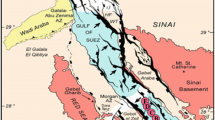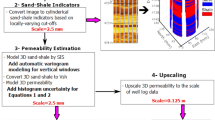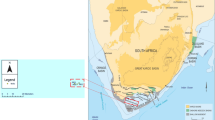Abstract
Sandstones of different ages provide economically significant oil, gas, and water reservoirs. In sandstones where heterogeneities are not visually obvious, it is particularly difficult to predict the location of permeability barriers and the scale at which high and low permeability zones occur, yet this is critical in providing information on hydrocarbon reservoir performance. This study uses variogram analysis to investigate spatial variation in permeability in visually homogeneous reservoir sandstone successions. Air permeability measurements were taken using unsteady state probe permeametry following regular grid schemes with centimeter spacing. Spatial variation in permeability was characterized using omnidirectional and directional variograms. This study combines variography with geological interpretation to assess the degree of heterogeneity of permeability in visually homogeneous sandstone successions. Variography indicates spatial dependence and short-range variation at 1 cm grid spacings that is not apparent at a larger 5 cm grid spacing in the visually homogeneous sandstones studied. The range of the models fitted to the variograms provide a potentially important index of spatial variability in permeability for different depositional settings including aeolian, fluvial, shallow marine, and marine/mass- flow turbidite.
Similar content being viewed by others
REFERENCES
Buckman, J. O., Doughty, P. S., Benton, M. J., and Jeram, A. J., 1998, Palaeoenvironmental interpre-tation of the Triassic sandstones at Scrabo, County Down, Northern Ireland: Ichnological and sedimentological studies indicating a mixed fluviatile-aeolian succession: Ir. J. Earth Sci., v. 16, p. 85–102.
Corbett, P. W. M., and Jensen, J. L., 1992, Variation of reservoir statistics according to sample spacing and measurement type for some intervals in the Lower Brent Group: The Log Analyst, p. 22–39.
Core Laboratories Instruments, 2001, PPP-250 TM Portable Probe Permeameter, Operators Manual, 4 p.
Cressie, N., and Hawkins, D. M., 1980, Robust estimation of the variogram: Math. Geol., v. 12, p. 115–125.
Daws, J. A., and Prosser, D. J., 1992, Scales of permeability heterogeneity within the Brent group: J. Pet. Geol., v. 15, no. 4, p. 397–418.
Deutsch, C. V., 1999, Reservoir modeling with publicly available software: Comput. Geosci., v. 25, p. 355–363.
Dreyer, T., Scheie, A., and Walderhaug, O., 1990, Minipermeameter-based study of permeability trends in channel sand bodies: Bull. Am. Assoc. Pet. Geol., v. 74, no. 4, p. 359–374.
Fisher, S. R., Barton, M. D., and Tyler, N., 1993, Quantifying reservoir heterogeneity through outcrop characterization: 1. Architecture, lithology and permeability distribution of landward-stepping fluvial-deltaic sequence, Ferron sandstone (Cretaceous), Central Utah: Gas Research Institute Topical Report No. GRI-93/0022, p. 49–89.
Fowles, J., and Burley, S., 1994, Textural and permeability characteristics of faulted, high porosity sandstones: Mar. Pet. Geol., v. 11, no. 5, p. 608–623.
Galehouse, J. S., 1971, Point counting, in Carver R. E., ed., Procedures in sedimentary petrology: Wiley-Interscience, New York, p. 385–409.
Goggin, D. J., Chandler, M. A., Kocurek, G., and Lake, L. W., 1986, Patterns of permeability in Eolian deposits: SPE/DOE 14893: 5th Symposium on Enhanced Oil Recovery, Tulsa, p. 181 188.
Goggin, D. J., Thrasher, R. L., and Lake, L. W., 1988, A theoretical and experimental analysis of minipermeameter response including gas slippage and high velocity flow effects: In Situ, v. 12, p. 79–116.
Hurst, A., Cronin, B., and Hartley, A., 2000, Reservoir modelling sand-rich deep water clastics: The necessity of down-scaling: Pet. Geosci., v. 6, p. 67–76.
Isaaks, E. H., and Srivastava, R. M., 1989, An introduction to applied geostatistics: Oxford University Press, New York, 561 p.
Jensen, J. L., Corbett, P. W. M., Pickup, G. E., and Ringrose, P. S., 1996, Permeability variograms, geological structure, and flow performance: Math. Geol., v. 28, p. 419–435.
Jones, S. C., 1992, The profile permeameter: A new, fast, accurate minipermeameter: Paper presented at the 67th Annual Technical Conference and Exhibition of the Society of Petroleum Engineers, Washington, DC, October, SPE 24757, p. 973–983.
Journal, A. G., and Huijbregts, C. J., 1978, Mining geostatistics: Academic Press, Orlando, 600 p.
Marshall, G., 2001, The Hibernian Greensand in N. Ireland: Petrography, reservoir characterisation, geochemistry and formation of glauconite and phosphates: Unpublished PhD Thesis, The Queen University of Belfast, 271 p.
Martinius, A. W., and Nieuwenhuijs, R. A., 1995, Geological description of flow units in channel sandstones in a fluvial reservoir analogue (Loranco Basin, Spain): Pet. Geosci., v. 1, p. 237–252.
McKinley, J. M., Worden, R. H., and Ruffell, A. H., 2001, Contact diagenesis: The effect of an intrusion on reservoir quality in the Triassic Sherwood Sandstone Group, N. Ireland: J. Sed. Res., v. 71, no. 3, p. 484–495.
Pebesma, E. J., and Wesseling, C. G., 1998, Gstat, a program for geostatistical modelling, prediction and simulation: Comput. Geosci., v. 24, p. 17–31.
Pettijohn, F. J., Potter, P. E., and Siever, R., 1987, Sand and sandstone, 2nd edn.: Springer-Verlag, New York, 553 p.
Prosser, D. J., McKeever, M., Hogg, A. J. C., and Hurst, A., 1995, Permeability heterogeneity within massive Jurassic submarine fan sandstones from the Miller Field, northern North Sea, UK, inHartley, A. J., and Prosser, D. J., eds., Characterization of deep marine clastic systems: Geological Society, London, Special Publication, Vol. 94, p. 201–219.
Robertson, G. M., and McPhee, C. A., 1990, High resolution probe permeability: An aid to reservoir description, in Worthington, P., ed., Advances in core evaluation accuracy and precision in reserves estimation: Reviewed proceedings of the First Society of Core Analysts, European Core Analysis Symposium, London, UK: Gordon and Breach, New York, p. 495–520.
Sharp, W. E., 1982, Estimation of semivariograms by the maximum entropy method: Math. Geol., v. 14, p. 457–474.
Van Der Plas, L., and Tobi, A. C., 1965, A chart for judging the reliability of point counting results: Am. J. Sci., v. 263, p. 87–90.
Van Houten, F. B., and Purucker, M. E., 1984, Glauconitic Peloids and Chamosite Ooids—Favourable factors, constraints and problems: Earth Sci. Rev., v. 20, 211–243.
Wignall, P. B., and Pickering, K. T., 1993, Palaeoecology and sedimentology across a Jurassic fault scarp: NE Scotland: J. Geol. Soc. Lond., v. 150, p. 323–340.
Author information
Authors and Affiliations
Rights and permissions
About this article
Cite this article
McKinley, J.M., Lloyd, C.D. & Ruffell, A.H. Use of Variography in Permeability Characterization of Visually Homogeneous Sandstone Reservoirs with Examples from Outcrop Studies. Mathematical Geology 36, 761–779 (2004). https://doi.org/10.1023/B:MATG.0000041178.73284.88
Issue Date:
DOI: https://doi.org/10.1023/B:MATG.0000041178.73284.88




